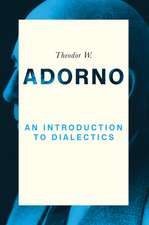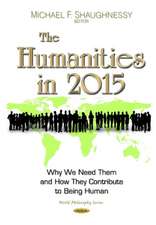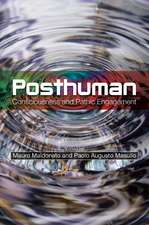The Future of the Ancient World: Essays on the History of Consciousness
Autor Jeremy Naydleren Limba Engleză Paperback – 24 iul 2009
Preț: 96.24 lei
Preț vechi: 115.84 lei
-17% Nou
Puncte Express: 144
Preț estimativ în valută:
18.42€ • 20.02$ • 15.48£
18.42€ • 20.02$ • 15.48£
Carte disponibilă
Livrare economică 04-16 aprilie
Preluare comenzi: 021 569.72.76
Specificații
ISBN-13: 9781594772924
ISBN-10: 1594772924
Pagini: 320
Ilustrații: 111 b&w illustrations
Dimensiuni: 152 x 229 x 23 mm
Greutate: 0.39 kg
Editura: Inner Traditions/Bear & Company
Colecția Inner Traditions
Locul publicării:United States
ISBN-10: 1594772924
Pagini: 320
Ilustrații: 111 b&w illustrations
Dimensiuni: 152 x 229 x 23 mm
Greutate: 0.39 kg
Editura: Inner Traditions/Bear & Company
Colecția Inner Traditions
Locul publicării:United States
Notă biografică
Jeremy Naydler, Ph.D., is a philosopher who specializes in the religious life of ancient cultures. He is a Fellow of the Temenos Academy and author of Temple of the Cosmos, Shamanic Wisdom in the Pyramid Texts, and Goethe on Science. He lives in Oxford, England.
Extras
THE RESTITUTION OF THE EAR
This essay traces the historical process by which the sense of sight usurped the sense of hearing as the primary metaphor of human mental functions. It argues that through the reinstatement of listening rather than looking as the basis of our model for relating to the world, it becomes possible for a more open, responsive, and participative relationship with nature to arise.
The essay is based on a talk given for the Oxford Centre for Human Relations entitled “The Seeing and Listening Mind.”1
IN QUEST OF THE MIND'S EAR
We have become so accustomed to thinking of our mental processes under the metaphor of the sense of sight that we scarcely notice we do it--let alone reflect on its significance. Words abound in our vocabulary, which express functions of the mind in terms of visual functions: we have “views,” we “look” at things from a certain “perspective,” we “speculate,” we “focus” on some issue, are “short-sighted,” “far-sighted,” or even “visionary,” and when we have gained “insight” into someone’s “point of view” we “see” what they mean.
Why is it that the sense of sight has assumed this role of the model on which we tend to represent to ourselves the workings of our minds? What is the deeper meaning of the fact that our modern Western consciousness finds in the visual experience--rather than the experience of touch, taste, smell, or hearing--the one that most closely approximates our experience of thinking and understanding?
For it has not always been so. In the ancient civilization of Sumeria, it would seem that the ear was felt to be the sense organ that corresponded in its functioning most closely to that of the mind. Enki, the Sumerian god of wisdom, who was said to know all things, was described as “he whose ears are wide open.” And when the great goddess Inanna contemplated her initiatory journey into the Underworld, we read that she “opened her ear to the Great Below.”
Whereas for us the sensory metaphor most often associated with wisdom is “far-sightedness,” implying a practical ability to plan effectively for the future, for the Sumerians the equivalent expression would have been “depth of ear,” implying a more contemplative, more inward attunement to the spiritual forces active in the present. The image evoked by the expression “far-sightedness” is that of a commanding hilltop view of a landscape spread out before the “mind’s eye”; the image that the expression “depth of ear” gives rise to is that of the still, silent waters of a lake or well below the earth’s surface, which--appropriately--were the abode of Enki, god of wisdom.
In ancient Egypt, too, a comparable association was made between the ear, or the act of hearing, and our mental faculties. In the Old Kingdom Instructions of Ptahhotep, we read how
The fool who does not hear can do nothing at all.
He sees knowledge in ignorance.6
And again:
He who hears is beloved of God,
he whom God hates does not hear. 7
Whereas the eye shows us the surfaces of things--their extension in space, their form and color--the ear reveals to us that which is hidden from the eye. The ear, unlike the eye, is physiologically a very internal organ; and what is expressed in sound pertains more to the inner nature of a thing or creature. The sound an animal makes gives us an experience of what is happening in its soul, which no amount of looking would communicate to us.
In listening, the mind must quiet itself to a point of stillness and attentiveness. Listening is a receptive, participative activity in which we allow certain qualities of the being to whom we are listening to resound within us. The functioning of the eye is quite different. Instead of this built-in contemplative quality, there is a kind of pragmatism entailed by the eye’s demand for distance between us and the object of our gaze. The eye asks us to engage in a practical, instrumental relationship to the world, whereas the ear seems to invite us to overcome our separation from objects that the eye locates “out there” and to involve ourselves with them in a more participative form of knowing.
THE RISE OF THE EYE
It was the Greeks who first introduced the eye as the primary metaphor of mental functions. Already, in Homer, we begin to suspect as much when the “bright-eyed” Athena intervenes in the thought processes of various heroes. In chapter 1 of the Iliad she causes Achilles to reflect instead of following his initial violent impulse to attack Agamemnon; and it is significant that it is she who is the deity closest to the wily Odysseus, inspiring him with his clever plans. Athena’s symbolic animal was, aptly enough, the wide-eyed owl.
The genius of the Greek language is still more revealing than its mythology, especially as the former evolved to accommodate more abstract and philosophical concepts. By the fourth century BC, the verb idein was used equally to express seeing and knowing, the congruence of meaning being so complete that the past oida was used both in the sense of “I have seen” and “I know.” For the Greeks, when one has seen, one knows. This coalescence of meaning was retained in the derivative noun idea, which expressed both the inner nature of a thing (what kind of thing it is) and its visible form or appearance. Similarly the noun theoria denoted both contemplation and beholding or observing. Its verb, theorein, was employed to describe both the activity of spectators at public games and festivals and that of the philosopher.8 Clearly, for the Greeks the activity of thinking was felt to imply a distancing of self from object similar to that which arises between observer and observed in the exercise of the sense of sight.
This essay traces the historical process by which the sense of sight usurped the sense of hearing as the primary metaphor of human mental functions. It argues that through the reinstatement of listening rather than looking as the basis of our model for relating to the world, it becomes possible for a more open, responsive, and participative relationship with nature to arise.
The essay is based on a talk given for the Oxford Centre for Human Relations entitled “The Seeing and Listening Mind.”1
IN QUEST OF THE MIND'S EAR
We have become so accustomed to thinking of our mental processes under the metaphor of the sense of sight that we scarcely notice we do it--let alone reflect on its significance. Words abound in our vocabulary, which express functions of the mind in terms of visual functions: we have “views,” we “look” at things from a certain “perspective,” we “speculate,” we “focus” on some issue, are “short-sighted,” “far-sighted,” or even “visionary,” and when we have gained “insight” into someone’s “point of view” we “see” what they mean.
Why is it that the sense of sight has assumed this role of the model on which we tend to represent to ourselves the workings of our minds? What is the deeper meaning of the fact that our modern Western consciousness finds in the visual experience--rather than the experience of touch, taste, smell, or hearing--the one that most closely approximates our experience of thinking and understanding?
For it has not always been so. In the ancient civilization of Sumeria, it would seem that the ear was felt to be the sense organ that corresponded in its functioning most closely to that of the mind. Enki, the Sumerian god of wisdom, who was said to know all things, was described as “he whose ears are wide open.” And when the great goddess Inanna contemplated her initiatory journey into the Underworld, we read that she “opened her ear to the Great Below.”
Whereas for us the sensory metaphor most often associated with wisdom is “far-sightedness,” implying a practical ability to plan effectively for the future, for the Sumerians the equivalent expression would have been “depth of ear,” implying a more contemplative, more inward attunement to the spiritual forces active in the present. The image evoked by the expression “far-sightedness” is that of a commanding hilltop view of a landscape spread out before the “mind’s eye”; the image that the expression “depth of ear” gives rise to is that of the still, silent waters of a lake or well below the earth’s surface, which--appropriately--were the abode of Enki, god of wisdom.
In ancient Egypt, too, a comparable association was made between the ear, or the act of hearing, and our mental faculties. In the Old Kingdom Instructions of Ptahhotep, we read how
The fool who does not hear can do nothing at all.
He sees knowledge in ignorance.6
And again:
He who hears is beloved of God,
he whom God hates does not hear. 7
Whereas the eye shows us the surfaces of things--their extension in space, their form and color--the ear reveals to us that which is hidden from the eye. The ear, unlike the eye, is physiologically a very internal organ; and what is expressed in sound pertains more to the inner nature of a thing or creature. The sound an animal makes gives us an experience of what is happening in its soul, which no amount of looking would communicate to us.
In listening, the mind must quiet itself to a point of stillness and attentiveness. Listening is a receptive, participative activity in which we allow certain qualities of the being to whom we are listening to resound within us. The functioning of the eye is quite different. Instead of this built-in contemplative quality, there is a kind of pragmatism entailed by the eye’s demand for distance between us and the object of our gaze. The eye asks us to engage in a practical, instrumental relationship to the world, whereas the ear seems to invite us to overcome our separation from objects that the eye locates “out there” and to involve ourselves with them in a more participative form of knowing.
THE RISE OF THE EYE
It was the Greeks who first introduced the eye as the primary metaphor of mental functions. Already, in Homer, we begin to suspect as much when the “bright-eyed” Athena intervenes in the thought processes of various heroes. In chapter 1 of the Iliad she causes Achilles to reflect instead of following his initial violent impulse to attack Agamemnon; and it is significant that it is she who is the deity closest to the wily Odysseus, inspiring him with his clever plans. Athena’s symbolic animal was, aptly enough, the wide-eyed owl.
The genius of the Greek language is still more revealing than its mythology, especially as the former evolved to accommodate more abstract and philosophical concepts. By the fourth century BC, the verb idein was used equally to express seeing and knowing, the congruence of meaning being so complete that the past oida was used both in the sense of “I have seen” and “I know.” For the Greeks, when one has seen, one knows. This coalescence of meaning was retained in the derivative noun idea, which expressed both the inner nature of a thing (what kind of thing it is) and its visible form or appearance. Similarly the noun theoria denoted both contemplation and beholding or observing. Its verb, theorein, was employed to describe both the activity of spectators at public games and festivals and that of the philosopher.8 Clearly, for the Greeks the activity of thinking was felt to imply a distancing of self from object similar to that which arises between observer and observed in the exercise of the sense of sight.
Cuprins
Introduction
Part One
Beyond What the Eyes Can See
1 The Restitution of the Ear
In Quest of the Mind’s Ear
The Rise of the Eye
Visual Totalitarianism
Rehabilitating the Ear
2 The Heart of the Lily
The Depiction of Plants in the Middle Ages
The Scientific Perception of the Lily
The Fallacy of Misplaced Concreteness
The Lily as Epiphany
The Heart of the Lily
3 The Soul of the Weather
An Epistemological Prelude
The Wind Spirits of Antiquity
Esoteric Meteorology of the Renaissance
Measuring the Gods
The Demise of the Visionary Faculty
The Weather Abstracted
Return to Experience
4 The Reality That Is Not There
Locational Space
The Kingdom We Do Not See
Nonlocational Space
Space in Premodern Cosmologies
Space in Modern Cosmology
Pathways into Nonlocational Space
Part Two
Deepening Our Foundations: The Gods and Ancient Egypt
5 Ancient Egypt and the Soul of the West
The Inward Migration to Ancient Egypt
The Drive to Solidify the World
A New Alignment
6 On the Divinity of the Gods
The New Dawn of Polytheism
God and the Gods
Gods and Humans
Soul and Spirit
7 The Artist as Priest
Reflections on the Sacred Art and Culture of Ancient Egypt
Isfet and Maat
The Art of Animating Images
Art and Magic
Portraying the Imaginal
The Artist as Priest
The Responsibility of the Artist
8 Ancient Egypt and Modern Esotericism
The Fascination with Ancient Egypt
The Imaginary versus the Imaginal
The Hidden Realm
The Three Tasks
Part Three
The Path of Consciousness
9 Being Ancient in a Modern Way
Divination in the Light of the History of Consciousness
The Yearning to Reconnect
Extispicy in Ancient Mesopotamia
Extispicy in Ancient Greece and Rome
The Decline of the Divinatory Consciousness The Rise of the Autonomous Moral Agent
Being Ancient in a Modern Way
10 The Future of the Ancient World
Meaning in History
Gods in the Psyche
Gods in Nature
Ancient Consciousness of the Gods
The Soul Comes of Age
Future Return
11 Christ and the Gods
Between Polytheism and Monotheism
The Gods and the Psyche
The Judaic Path to Monotheism
The Greek Retreat from the Gods
The Logos Incarnate
Polytheistic Perspectives on Christ
Gods and Angels
Return to Source
12 Pathways into the Future from the Deep Past
The Cosmological Context: Reflections on an Old Hindu Myth
Ancient Star Wisdom: The Path to Cosmic Union
Commitment to the Earth: Aristotle, Christ, and Modern Spirituality
Notes
Bibliography
Illustration Sources
Index
Part One
Beyond What the Eyes Can See
1 The Restitution of the Ear
In Quest of the Mind’s Ear
The Rise of the Eye
Visual Totalitarianism
Rehabilitating the Ear
2 The Heart of the Lily
The Depiction of Plants in the Middle Ages
The Scientific Perception of the Lily
The Fallacy of Misplaced Concreteness
The Lily as Epiphany
The Heart of the Lily
3 The Soul of the Weather
An Epistemological Prelude
The Wind Spirits of Antiquity
Esoteric Meteorology of the Renaissance
Measuring the Gods
The Demise of the Visionary Faculty
The Weather Abstracted
Return to Experience
4 The Reality That Is Not There
Locational Space
The Kingdom We Do Not See
Nonlocational Space
Space in Premodern Cosmologies
Space in Modern Cosmology
Pathways into Nonlocational Space
Part Two
Deepening Our Foundations: The Gods and Ancient Egypt
5 Ancient Egypt and the Soul of the West
The Inward Migration to Ancient Egypt
The Drive to Solidify the World
A New Alignment
6 On the Divinity of the Gods
The New Dawn of Polytheism
God and the Gods
Gods and Humans
Soul and Spirit
7 The Artist as Priest
Reflections on the Sacred Art and Culture of Ancient Egypt
Isfet and Maat
The Art of Animating Images
Art and Magic
Portraying the Imaginal
The Artist as Priest
The Responsibility of the Artist
8 Ancient Egypt and Modern Esotericism
The Fascination with Ancient Egypt
The Imaginary versus the Imaginal
The Hidden Realm
The Three Tasks
Part Three
The Path of Consciousness
9 Being Ancient in a Modern Way
Divination in the Light of the History of Consciousness
The Yearning to Reconnect
Extispicy in Ancient Mesopotamia
Extispicy in Ancient Greece and Rome
The Decline of the Divinatory Consciousness The Rise of the Autonomous Moral Agent
Being Ancient in a Modern Way
10 The Future of the Ancient World
Meaning in History
Gods in the Psyche
Gods in Nature
Ancient Consciousness of the Gods
The Soul Comes of Age
Future Return
11 Christ and the Gods
Between Polytheism and Monotheism
The Gods and the Psyche
The Judaic Path to Monotheism
The Greek Retreat from the Gods
The Logos Incarnate
Polytheistic Perspectives on Christ
Gods and Angels
Return to Source
12 Pathways into the Future from the Deep Past
The Cosmological Context: Reflections on an Old Hindu Myth
Ancient Star Wisdom: The Path to Cosmic Union
Commitment to the Earth: Aristotle, Christ, and Modern Spirituality
Notes
Bibliography
Illustration Sources
Index
Recenzii
“Naydler makes the ancient texts and symbols come alive for us. Where other writers leave us confused, he brings clarity to difficult notions about the hidden side of existence.”
". . . full of rich insights into history and culture that enable us to understand our own story and decide which elements need to be carried forward into the future."
"This collection of essays is packed full of gems and amazing insights, and it's certainly a book I will re-read and use for reference."
". . . full of rich insights into history and culture that enable us to understand our own story and decide which elements need to be carried forward into the future."
"This collection of essays is packed full of gems and amazing insights, and it's certainly a book I will re-read and use for reference."
Descriere
The sacred consciousness that prevailed in antiquity is the key to unlocking our future.













